|
|
 |
|
|
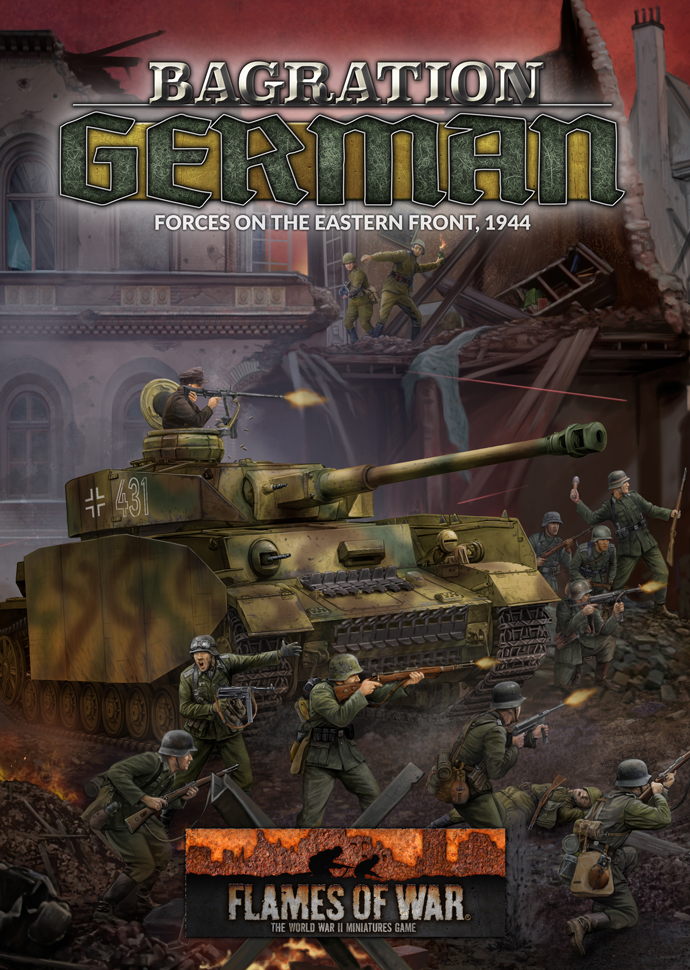 |
2. Gebirgsdivision and 6. SS-Gebirgsdivision 'Nord' on the Western Front 1945
By Derek Body and Wayne Turner
2. Gebirgsdivision
After the Anschluss (the incorporation of Austria into Germany) 2. Gebirgsdivision was formed from the Austrian 6th Division in Innsbruck on 1 April 1938 as part of Wehrkreis XVIII (Military District 18). On 26 August 1939 the division was mobilised and in September it took part in the Polish campaign as part of Heeresgruppe Sud (Army Group South).
Poland
2. Gebirgsdivision fought alongside 1. Gebirgsdivision in Poland, their main goal being the capture of Lemberg (Lvov, Lviv), the Galician provincial capital and an important communications and rail hub.
|
| The division entered Poland from Käsmark (Kežmarok) in Slovakia, marching on foot through Nida, Neu Sandec and Jasslo, capturing the Dukla Pass on the way, before reaching Lemberg. They made fast progress through the mountains and hilly terrain of the Slovakian and Polish border region, and once in Poland 2. Gebirgsdivision quickly linked up with 1. Gebirgsdivision, who had taken a northern approach across the border. By 11 September both division had covered well over 240km (150 miles). On14 September they had reached the foot hills around Lemberg. 1. Gebirgsdivision formed a Kampfgruppe to attack the city, while the rest of the two divisions formed a cordon around Lemberg to prevent arriving Polish troops from relieving the besieged city. Fighting with the Polish garrison and relieving forces was fierce, but after six days the Polish defenders finally surrendered, but only if they were allowed to surrender to the German Gebirgsjäger and not to the recently arrived Soviet troops. The victorious Gebirgsjäger then had to hand the city over to the Soviets, who had belatedly joined the invasion of Poland. |
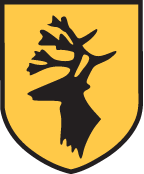 |
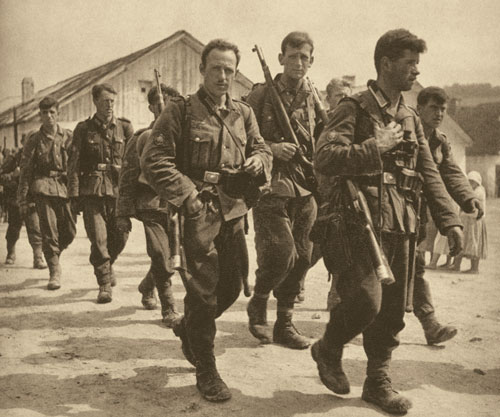 |
Norway
After the Polish campaign 2. Gebirgsdivision and 3. Gebirgsdivision were selected to take part in the invasion of Norway. 3. Gebirgsdivision’s target was Narvik in the north of Norway. One regiment was loaded aboard 10 Destroyers of the Kriegsmarine (German Navy) and headed north. The German destroyers sunk two Norwegian coastal defence ships before entering Narvik Port and unloading the Gebirgsjäger. The Norwegians surrendered and on 9 April 1940 the port of Narvik was in German hands. However, supplies were short, as only one supply ship had reached Narvik.
|
|
The following morning the German Destroyers were attacked by a fleet of British Destroyers and two German ships were sunk. On 13 April the British attacked again, this time with heavy support from the Battleship HMS Warspite and the remaining eight German Destroyers were sunk. Without their naval support the Gebirgsjäger were somewhat stranded. The British and French had also landed troops 64km (40 miles) to the north. With over 15,000 Allied troops closing on Narvik, the trapped Gebirgsjäger and Kriegsmarine sailors had little choice but to fight and hope for relief. Despite the rest of 3. Gebirgsdivision racing to relieve their comrades, the Allies withdrew on 8 June, and Norway formally surrendered, before defeating the isolated Gebirgsjäger.
2. Gebirgsdivision had meanwhile landed in Trondheim, joining the rest of 3. Gebirgsdivision in their attempt to relieve Gebirgsjager-Regiment 139 in Narvik. With the Norwegian surrender the division moved to the far north to take up occupation duties.
|
|
Barbarossa
In 1941 the division was in Lapland to participate in Operation Silberfuchs (Silverfox), the attack on the Soviet Arctic as part of Operation Barbarossa. Their target was the Soviet arctic port of Murmansk. As part of Gebirgsskorps Nowegen (Mountain Corps Norway) they were once more teamed with 3. Gebirgsdivision. Fighting through horrible Mosquito infested terrain that consisted of barren rock, swampland, and dark dank forests, the Gebirgsjäger initially made good progress, smashing through the Soviet defences until reaching the River Liza in early July,
|
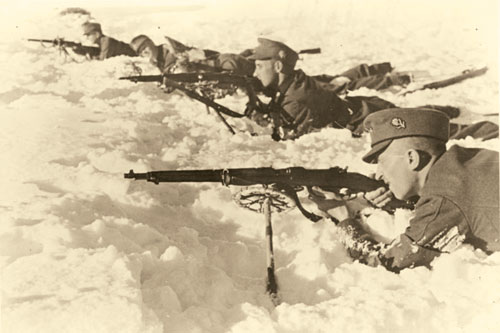 |
| when Soviet resistance began to stiffen. The Soviets began to counterattack, but the Gebirgsjäger held them. However, the forward momentum of the offensive had stumbled to a halt. 3. Gebirgsdivision was replaced by 6. Gebirgsdivision, which formed with 2. Gebirgsdivision the XIX Gebirgskorps (19th Mountain Corps). |
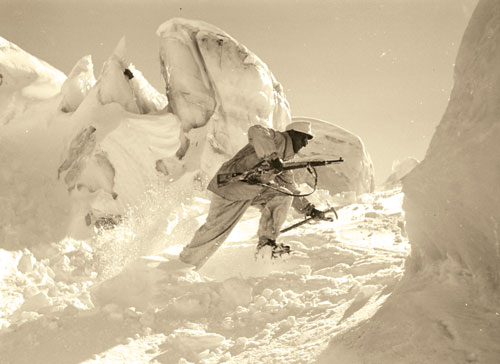 |
Northern Finland
During the winter the Soviets launched a major counter-offensive. Despite heavy casualties XIX Gebirgskorps held its ground throughout the Winter of 1941/42 and a stalemate developed in the sector. Minor raids and skirmishes were carried out, but no heavy fighting occurred while both side rebuilt for the spring.
When Spring arrived, so did another major Soviet offensive. The Soviet offensive combined land and seaborne assaults in an attempt to cut off and isolate elements of the Gebirgskorps.
|
|
The mountain troops held, but another Soviet attack almost succeed, but the timely intervention of bad weather brought all action to a halt. The weather respite allowed the Germans time to regroup and reorganise their defences.
1943 was spent once more in stalemate, with minor actions and no major offensives. However, in the Summer of 1944 the Soviets were in an offensive mood and the far north was not ignored. The Soviet offensive in Finland finally forced the Finns to the negotiation table and a peace treaty was signed in September 1944.
In late 1944 2. Gebirgsdivision withdrew to Norway and then transferred to Denmark, after a fighting retreat against the Finns, as the Finns fulfilled their treaty obligations to expel the Germans from Finland. In December 1944 the Division was sent to Denmark to refit.
|
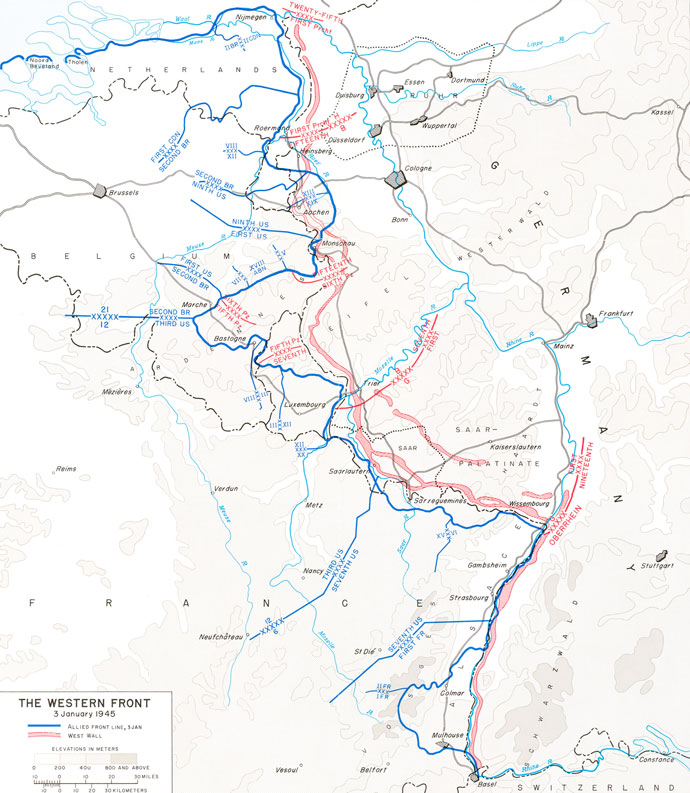 |
|
To the West
In January 2. Gebirgsdivision was moved to the Western Front to reinforce the Colmar Pocket on the Franco-German border in Alsace. They were stationed around the Neuf-Brisach bridgehead in the northeast of the pocket.
The French and Americans launched Operation Cheerful on 20 January 1945, their aim was to clear the German forces from the pocket and secure crossing over the Rhine River into Germany. The attack was started in a heavy snowstorm, the sort of conditions the Gebirgsjäger were well familiar with from their fighting in Finland. The attack around Mulhouse by the French 1er Corps d’Armée was halted. However, the attack had successfully drawn the German reserves south and the French next attacked, two days later, the Erstein bulge, which lay to the north, just south of Strasbourg.
|
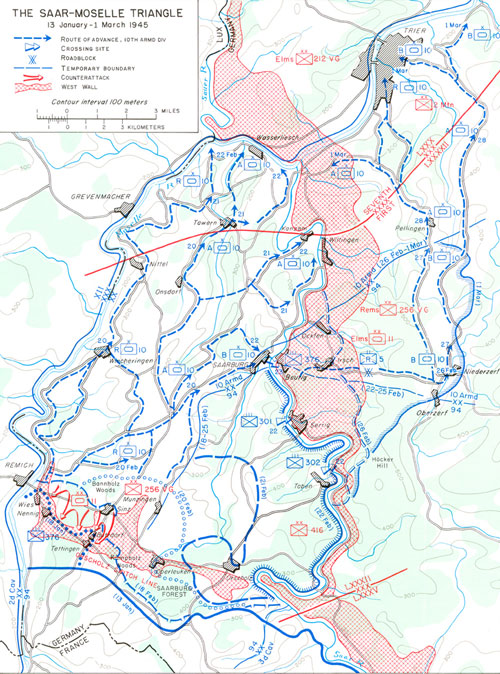 |
2. Gebirgsdivison came under attack from French and American forces on 24 January 1945. Gebirgsjäger-Regiment 136 held the town of Jebsheim. Between 24 January and 2 February a savage and bitter struggle for the town was fought, with it changing hands three times in nine days of fighting. The Gebirgsjäger were not alone in their defence and were supported by the Jagdpanther tank-hunters of 654. Schwere Panzerjägerabteilung. They faced the US 254th Infantry Regiment (attached to the 3rd Infantry Division), French 5th Armoured Division, Paratroopers, Foreign Legion, Moroccan cavalry and FFI troops. The Americans and French finally clear the town of the last Gebirgsjäger at 1500 hours on 2 February. However, 2. Gebirgsdivision still held the countryside around the town and fighting continued. Over the next few days the Germans continued to be pushed back in the pocket until finally permission was granted by Hitler for the Germans forces to withdraw from the Colmar Pocket across the Rhine. |
|
Saarpfalz and Trier
The division was next moved north to the Saarpfalz region in February 1945 where it was placed in the reserve of 1. Armee. 2. Gebirgsdivision replaced 559. Volksgrenadierdivision holding Bitche. After a short period of successful fighting most of the division was moved by motorised transport to the area south of Trier.
In late February the Americans began to push out of the Saar Brigdehead and advance towards the Rhine River. Fighting alongside 2. Gebirgsdivision was 212. Volksgrenadierdivision. An attack by the US 76th Infantry Division drew the Volksgrenadiers north away from Trier leaving the city lightly defended. The American 94th Infantry Division was then able to quickly take Trier.
However, the Germans quickly organised a counterattack to take back the city. Initially 256. Volksgrenadierdivision was committed to hold any further American advance before 2. Gebirgsdivision and 6. SS-Gebirgsdivison ‘Nord’ attacked between 3 and 4 March form Zerf to the south of Trier. The attack cleared some US infantry, but 2. Gebirgs division’s Hetzer tank-hunters soon became embroiled in a firefight with the tank-destroyers of the 778th Tank Destroyer Battalion. Finally, the 2. Gebirgsdivision attack was halted by US Artillery fire.
After the attack, the division was able to hold their positions until the middle of March, but suffered heavy casualties. The remnants of the division then retreated towards the Rhine near Germersheim.
Germany
This was followed by defensive battles in Southern Germany in Württemberg where further fighting almost destroyed the division. What was left of the division then retreated into the Tirol region in Austria where remnants surrendered to the Americans in May 1945.
|
|
Black Edelweiss: 6. SS Gebirgsdivision
SS-Kampfgruppe NORD was formed in February 1941 and were first deployed to Finland in June as a motorised infantry division, where they were renamed ‘SS-Division NORD’. The Finnish government was officially neutral at this time, but within days of their arrival Operation Barbarossa commenced and Soviet bombers and artillery began conducting attacks against bordering Finnish towns. Finland’s ‘Continuation War’ was renewed, and with Soviet forces reeling under the German assault, the Finns were quickly able to reclaim most of their lost territory.
|
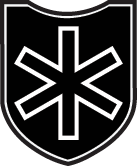 |
| The as yet untried SS-Division saw their first combat in the northern sector as part of Operation Silberfuchs (Silverfox) to sever the Murmansk Railway. Here they were ordered to frontally attack the heavily fortified Soviet position of Salla but were bloodily repulsed. This position was later double enveloped by 169. Infanteriedivision and the Finnish 6th Division, forcing the Soviets to withdraw. |
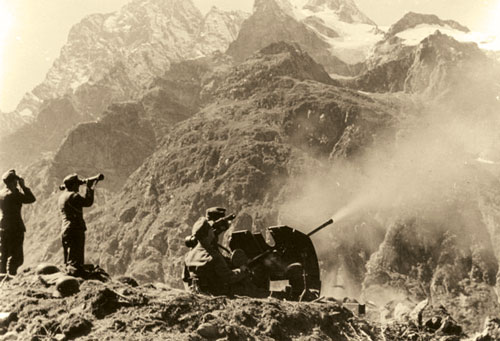 |
After their baptism by fire, elements of NORD were temporarily brought under Finnish command. The German troops benefited greatly from this close co-operation, sometimes Finnish platoons would work alongside German companies and they gained invaluable experience in dealing with the terrain and winter conditions. On a strategic level they also made use of Finnish motti (small-scale encirclement) tactics that were far superior to the wider encirclements common to German doctrine due to the heavily wooded terrain. |
|
By the end of the year the Soviets had been forced back to heavily defended strongpoints and with Finland’s small population (3.5 million) the cost of high attrition battles would result in the Murmansk railway remaining firmly under Soviet control.
The division slowly received reinforcements which were largely needed due to casualties caused by the bitterly cold winter conditions. These were often Volksdeutsche or ethnic Germans that helped evolve NORD into a multi-ethnic SS-Division. In 1942 both sides begun construction of sturdy defensive positions and operations were conducted to attack each other’s supply lines with the Soviets aided by partisans. The Soviets launched their spring offensive in late April which endeavoured to cut off the main German supply route employing the 23rd Guards Division, 8th Ski Brigade and 80th Independent Brigade. Successful employment of motti tactics alongside Finnish Division J countered this Soviet thrust while inflicting heavy casualties.
|
|
SS-Gebirgsdivision
In June the division was officially reorganised as a reinforced mountain division (SS-Gerbirgsdivision Nord). This was primarily a change for logistical reasons rather than the requirement to fight in alpine terrain. The equipment however was extremely useful and skis and sleds increased winter mobility greatly. Small groups aided by Finnish troops would conduct raids and demolish railway tracks which were duly repaired by Soviet forced labour camps.
|
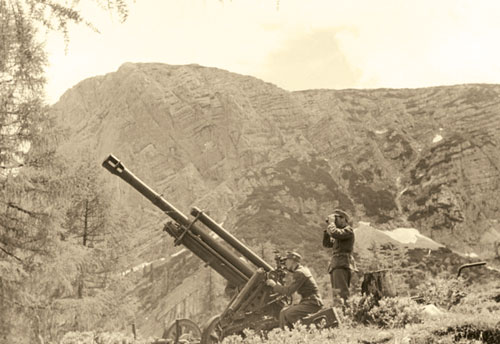 |
|
The stalemate situation largely continued through 1943. The division received their final designation as 6. SS-Gerbirgsdivision ‘Nord’. This comprised SS-Gerbirgsjäger-Regiment 11 ‘Reinhard Heydrich’ and SS-Gerbirgsjäger-Regiment 12 ‘Michael Gaißmair’ and also included two volunteer Norwegian units on the grounds that they were only to be employed against the Communist forces.
By 1944 the Soviets staged a major offensive on the Lagoda-Karelia front which caused Finland to sue for a separate peace. 6. SS Gerbirgs therefore made plans to conduct a phased withdrawal (Operation Birke). The Soviets demanded that the Finns forcibly intern all German troops after 15 September, firefights broke out between the German rearguard and Finnish forces and they finally left Finnish soil in early November. After 3½ years of fighting shoulder to shoulder with the Finns they parted as respected foes, but many were bitter about the apparent betrayal of their close ally.
|
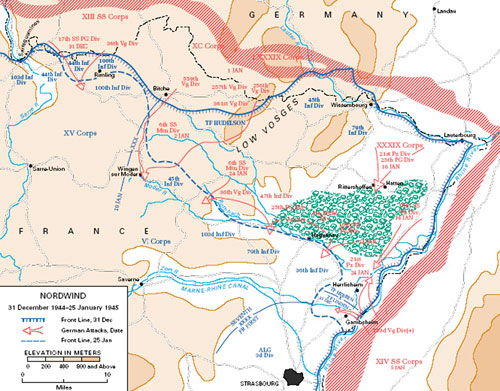 |
Nordwind
The division headed south through Norway and would eventually complete a 1,600 kilometre (1,000 mile) foot trek, briefly stopping in Denmark to receive new weapons and equipment. It was only now that they were issued with MG42 machine guns and each rifle battalion received a new heavy company consisting of a platoon of two 7.5cm infantry guns and another of four 12cm mortars.
These units would require training while the bulk of the division was urgently needed for deployment in conjunction with the Wacht am Rhein (Watch on the Rhine or Ardennes) offensive begun in mid December 1944.
|
|
This delay in transportation of units caused the division to only be committed piecemeal for the later Nordwind operation in the new year just as the Ardennes campaign was beginning to lose its impetus. They were however considered to be the freshest German force available in the West at the time.
Operation Nordwind began on New Year’s Day 1945 and was the last German offensive in the West. 6. SS-Gerbirgsdivision ‘Nord’ was tasked with the seizure of the town Wingen-sur-Moder and ultimately to open the Saverne Pass to allow an armoured breakthrough into the Rhine Valley. They received hasty training with their newly acquired panzerfausts and the lead elements began to infiltrate on 1 January. The main combat elements available were the 1st and 3rd battalions of SS-Gerbirgsjäger-Regiment 12. This force was designated Kampfgruppe Schreiber and were attached to 361. Volksgrenadierdivision.
|
|
The attack on Wingen-sur-Moder began on 4 January. The town was defended by the 179th Regiment of the 45th ‘Thunderbird’ Division. After a brief fight the town was overrun with approximately 300 Americans captured. A counterattack in the belief that a force of only ‘around 50 Germans’ had occupied the town was easily repulsed by the force of 725 German troops. The Germans however were unable to establish radio contact with headquarters to request urgent reinforcements to exploit this and the Americans soon surrounded the town.
|
 |
|
Troops from 276th Regiment (70th ‘Trailblazers’ Division) attacked on 5 January, but failed to dislodge the defenders. Kampfgruppe Schreiber were now running low on supplies and ammunition. When contact with headquarters was finally made the orders were to withdraw, but only a force of 205 managed to reach friendly lines. The high tidemark of Operation Nordwind had been reached without significant gain for the sacrifices made.
With American forces taking to the offensive troops of the 157th Infantry Regiment, 45th Division were ordered to seize the high ground near Reipertswiller on 14 January. Here SS-Gerbirgsjäger-Regiment 11 was able to entrap six companies with classic motti tactics. Desperate attempts to escape or relieve these forces were repelled by the Germans until a surrender ultimatum was agreed and 450 men were led away to captivity. With recent well publicised events of prisoner massacres still fresh in their minds the Americans were greatly relieved by their captors humane treatment. German forces were now fully on the defensive and would soon be forced to fight on their own soil. |
|
Defence of the Reich
After suffering under the Americans complete aerial dominance and overwhelming artillery, the SS troops had sustained heavy losses. They received paltry replacements and were ordered to recapture the town of Trier on the Moselle River in March, but were thwarted by the US 94th ‘Pilgrim’ Division. The American 3rd and 7th Armies offensive in the Saar-Palantine region was rapid and elements of NORD were largely cut-off and bypassed, only remnants of SS-Gerbirgsjäger-Regiment 11 were able to cross the Rhine River as the last combat effective unit of the division. They were involved in a series of costly delaying actions until the remaining force estimated at 800 were captured by the 5th ‘Red Diamond’ and 71st ‘Red Circle’ Divisions in early April 1945 near Frankfurt.
|
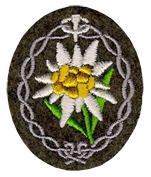 |
2. Gebirgsdivision and 6. SS-Gebirgsdivision 'Nord' in Flames Of War
The best way to field either of these mountain divisions is to use the Command Card from the Bagration: German Command Card pack. You can create a Gebirgsjager Company by applying the Gerbirgsjager Company card to a Grenadier Company from pages 16 to 19 of Bagration: German. This gives your HQ and Grenadier Platoons the Mountaineer special rule.
To give them mountain guns use the 7.5cm Mountain Artillery or 10.5cm Mountain Artillery cards to covert you 10.5cm Artillery Battery.
For the Panzergrenadier elements of the 6. SS-Gebirgsdivision 'Nord' field these with SS Panzergrenadiers from D-Day: Waffen-SS.
Notes: 6. SS-Gebirgsdivision 'Nord' did no have 10.5cm mountain artillery, so just field normal 10.5cm Artillery Batteries.
SS-Panzergrenadier-Bataillon 506 was part of 6. SS-Gebirgsdivision ‘Nord’. It was formed from Schützen-Bataillon (mot) 6 and wasn’t given the ‘506’ designation until the division was deployed on the western front. It was often used as a mobile reserve force for the SS-Gerbirgsjäger Regiments.
|
Last Updated On Tuesday, May 24, 2022 by Wayne at Battlefront
|
|
|